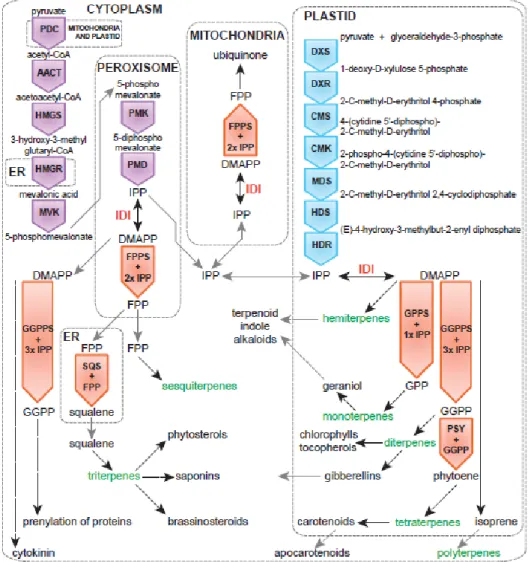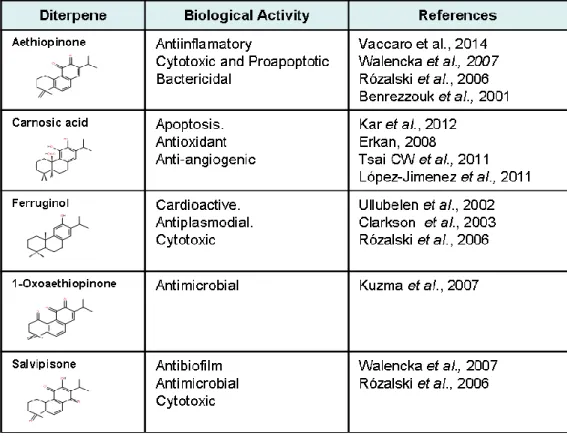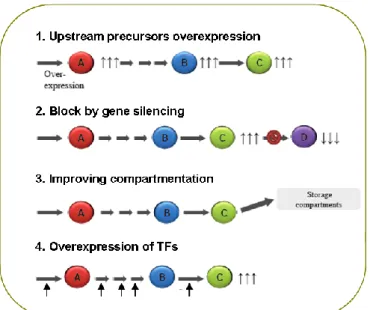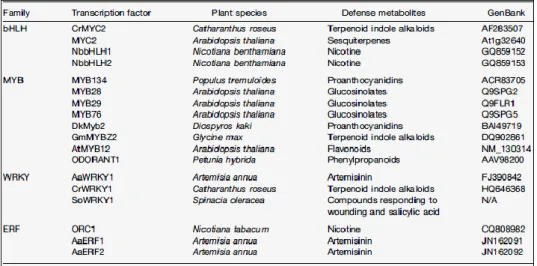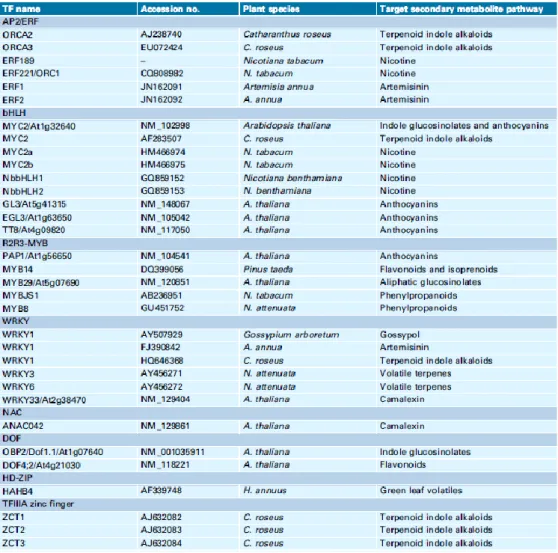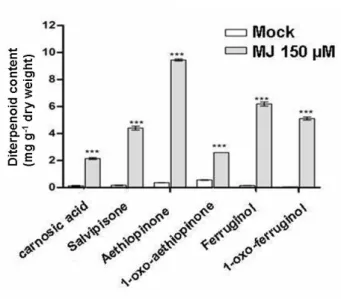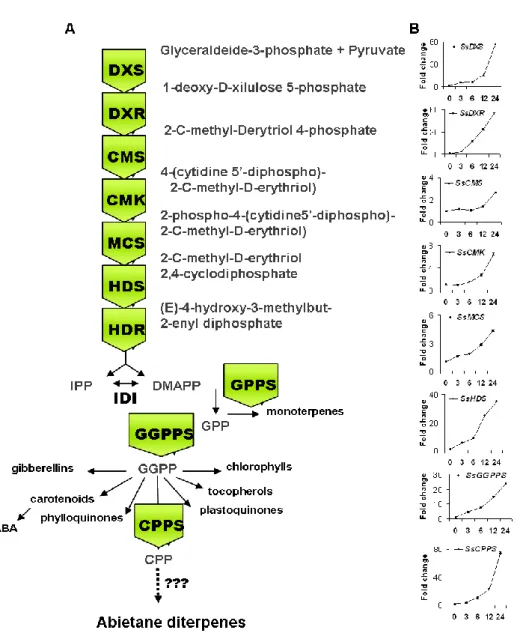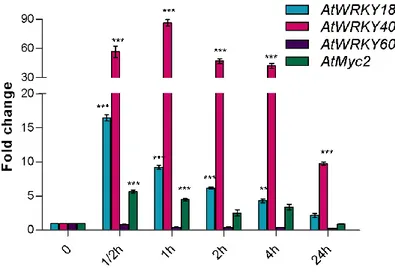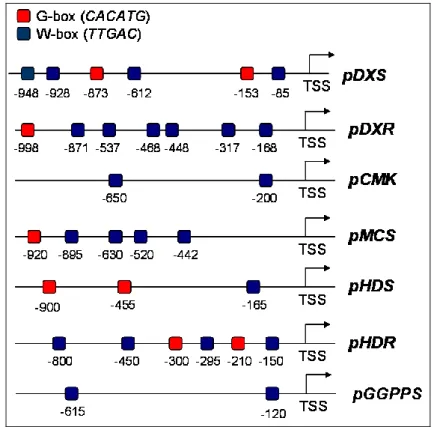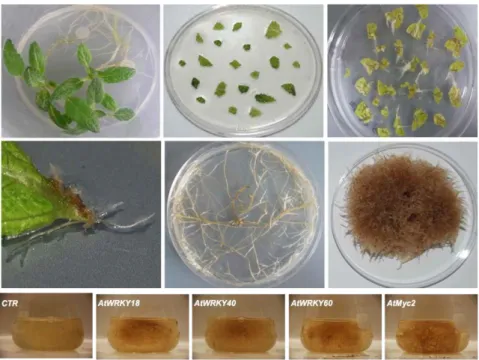UNIVERSITÀ DEGLI STUDI DI SALERNO
Dipartimento di Farmacia
Dottorato di ricerca
In Biologia dei Sistemi
Ciclo XIII (Nuova serie) - Anno di discussione 2015
Transcriptional regulation of biosynthetic genes of the plant
MEP-derived pathway to boost the metabolic flux
towards bioactive diterpenes
Settore scientifico disciplinare di afferenza: AGR/07
Dottorando Tutore
Dott. Mariaevelina Alfieri Chiar.mo Prof. Antonietta Leone
Coordinatore
3
5
« Da’ al mondo il meglio di te, e ti prendereranno a calci.
Non importa, da’ il meglio di te. »
Madre Teresa di Calcutta7
Index
Abstract………. 9
1. Introduction……… 13
1.1 Medicinal plants as source of bioactive molecules……….… 13
1.2 Hairy roots for the production of medicinal compounds………….……… 13
1.3 Plant isoprenoids……… 14
1.3.1 Isoprenoid biosynthesis in platid through DXP pathway……… 15
1.3.2 Plant diterpenoids……… 17
1.3.3 Abietane diterpenes synthesized in Salvia spp……… 17
1.4 Metabolic engineeing in plants……… 19
1.5 Targeting entire pathways with transcription factors……… 21
1.6 Transcriptional regulation of terpenoids……… 21
1.7 Transcription factors regulated by Methyl jasmonate……… 23
1.8. The WRKY transcription factors………. 25
1.9 The transcription factor Myc2……… 28
1.10 Diverting flux using loss of function approaches……… 29
1.11 Starting point of the present project……… 30
1.12 Aims of the project………... 31
2. Material and Methods……… 35
2.1 Plant material and growth conditions……… 35
2.2 Treatments……… 35
2.3 Bioinformatic analysis……… 35
2.4 Plasmid construction……… 35
2.5 S. sclarea hairy root cultures……… 35
2.6 Isolation of S.sEntCopalyl diphosphate synthase coding sequence……….. 36
2.7 RNA extraction and RT-PCR analysis……… 36
2.8 Quantitative real-time reverse transcription-PCR……… 36
2.9 Production of the recombinant AtWRKY18 protein……… 36
2.10 Electrophoretic mobility shift assay (EMSA)……… 37
2.11 Hairy root growth………... 37
2.12 Qualitative and quantitative determination of abietane diterpenes... 37
2.13 Statistical analysis……… 37
3. Results……… 41
3.1 Enhancing the synthesis of abietane diterpenes through coordinated activation of the MEP-derived metabolic pathway……… 41
3.1.1 Elicitation of S. sclarea hairy roots with Methyl-jasmonate (MJ) and quantitative analysis of bioactive abietane diterpenes……. 42
3.1.2 MJ treatment induces transcriptional activation of MEP-pathway biosynthetic genes……….. 42
3.1.3 Searching for MJ-inducible transcription factors regulating genes belonging to the plastidial MEP-derived pathway………. 44
3.1.4 Generation of S. sclarea hairy roots overexpressing AtWRKY and AtMyc2 TFs……… 46
3.1.5 AtWRKY18 overexpressing hairy roots……… 48
3.1.5.1 Molecular characterization of AtWRKY18 hairy root lines… 48 3.1.5.2 Growth of AtWRKY18 overexpressing hairy roots………… 49 3.1.5.3 Transcriptional levels of MEP-pathway biosynthetic
8
genes in AtWRKY18 hairy roots………. 50 3.1.5.4 Metabolic profile of AtWRKY18 overexpressing hairy
roots……… 51 3.1.5.4 Binding of AtWRKY18 to the AtDXS and AtDXR
Promoters………. 52 3.1.6 AtWRKY40 overexpressing hairy roots………. 53 3.1.6.1 Molecular characterization of AtWRKY40 hairy roots…… 53 3.1.6.2 Growth of AtWRKY40 overexpressing hairy roots…….. 54 3.1.6.3 Transcriptional levels of MEP-pathway biosynthetic
genes in AtWRKY40 hairy roots………. 55 3.1.6.4 Metabolic profile of AtWRKY40 overexpressing hairy
roots………. 56 3.1.7 AtWRKY60 overexpressing hairy roots……… 57 3.1.7.1 Molecular characterization of AtWRKY40 hairy roots….. 57 3.1.7.2 Growth of AtWRKY40 overexpressing hairy roots…… 57 3.1.7.3 Transcriptional levels of MEP-pathway biosynthetic
genes in AtWRKY40 hairy roots……….. 58 3.1.7.4 Metabolic profile of AtWRKY40 overexpressing hairy
roots………. 59 3.1.8 AtMyc2 overexpressing hairy roots……….. 60
3.1.8.1 Molecular characterization of AtWRKY40 hairy root
lines……….. 60 3.1.8.2 Growth of AtMyc2 overexpressing hairy roots……… 60 3.1.8.3 Transcriptional levels of MEP-pathway biosynthetic
genes in AtMyc2 hairy roots……….. 61 3.1.8.4 Metabolic profile of AtMyc2 overexpressing hairy roots… 62 3.2 Increasing the production of abietane diterpenes by blocking a
competitive lateral route of the MEP-derived pathway……… 63 3.2.1 Treatment of S. sclarea hairy roots with chlorocholine chloride
(CCC) and quantitative analysis of bioactive diterpenes in CCC-treated S. sclarea hairy roots……… 64 3.2.2 Growth of CCC-treated hairy roots……… 65 3.2.3 RNAi-mediated silencing of the gene EntCopalyl diphosphate
synthase... 65 3.2.3.1 Identification and characterization of the S. sclarea
EntCPPS gene……… 65
3.2.3.2 Generation of EntCPPS silenced S. sclarea hairy roots… 68 3.2.3.3 Growth and morphology of EntCPPS silenced S. sclarea
hairy roots……… 69 3.2.3.4 Metabolic profile of transgenic silenced root lines……… 70 4. Discussion
4.1 Enhancing the synthesis of abietane diterpenes through coordinated activation of the MEP-derived metabolic pathway……… 73 4.1.1 MJ-induced abietane diterpene production in S. sclarea hairy
roots is due to coordinated up-regulation of biosynthetic genes of the MEP-dependent pathway……… 73 4.1.2 Overexpression of AtWRKY and AtMYC2 TFs activates
transcription of biosynthetic genes belonging
9
4.1.3 Using TFs to boost production of abietane diterpenes in
S. sclarea hairy roots……… 77
4.1.4 Trade-off between growth and accumulation of
secondary metabolites……… 77 4.2 Increasing the production of abietane diterpenes by blocking a
competitive lateral pathway……… 79 5. Conclusions and perspectives……… 84
11 Abstract
This project was aimed at enhancing the synthesis of tri-cyclic bioactive abietane diterpenes (e.g. aethiopinone, 1-oxoaethiopinone, salvipisone, and ferruginol), synthesized in the roots of Salvia sclarea and other Salvia species, with known anti-inflammatory and antitumoral activities. There is a great demand of novel molecules to treat melanoma, the most aggressive form of skin cancer, since advanced stages are inevitably resistant to conventional therapeutic agents.We have recently shown that aethiopinone is cytotoxic against the human melanoma A357 cell line at a concentration not toxic to normal cells. In addition, by using the web server IdTarget a number of putative proteins overexpressed in melanoma were identified as potential cellular target of aethiopinone. Despite this interesting evidence, this compound can not be easily synthesized by chemical means, and it is only produced in the roots of Salvia species in minute amounts (less than 0.5% DW) wich are not sufficient to yield reliable amounts for a deeper understanding of their molecular targets and potential future commercialization.
In order to produce sufficient quantity of this interesting class of compounds, we targeted the plastidial terpenoid MEP-dependent pathway, from which they derive, by two different metabolic engineering strategies in S. sclarea hairy roots.
The first approach was based on the coordinated activation of MEP-pathway biosynthetic genes by elicitation or by overexpression of transcription factors. An enhanced content (about a 20-fold increase) of abietane diterpenes in S. sclarea hairy roots was induced by elicitation with Methyl-Jasmonate (MJ), due to the increased expression levels of the several MEP-pathway biosynthetic genes, indicating a possible coordinate gene regulation by transcription factors. Four transcription factors (WRKYs and Myc2) of A. thaliana were selected on the basis of the presence of MJRE-box in their promoter region. Overexpression of AtWRKY and AtMyc2 genes in S. sclarea hairy roots positively regulated transcription of several genes of the terpenoid MEP-pathway. High-level induced-expression of genes acting up-stream [1-Deoxy-D -Xylulose-5-Phosphate Synthase (DXS) and 1-Deoxy-D-Xylulose-5-Phosphate Reductoisomerase (DXR)] or downstream [geranylgeranyl-diphosphate synthase (GGPPS) and copalyl-diphosphate synthase (CPPS)] of this pathway, correlated with high-level of abietane-type diterpenes (3-5 fold increase). To our knowledge, this is the first evidence of TFs activating this specific diterpene pathway. One drawback of this strategy was the impaired growth, at varying level, of transgenic S. sclarea hairy roots. However, it was possible to select the best performing over-expressing hairy root lines in which high final biomass was coupled to high content of abietane diterpenes.
The second strategy was aimed at blocking the Ent-copalyl-diphosphate synthase (Ent-CPPS), the first enzyme acting at the lateral competing route from GGPP to gibberellins. Either chemical inhibition of the enzymatic activity of Ent-CPPS with CCC (chlorocholine chloride), a known plant growth retardant, or RNAi-mediated silencing of this gene in S. sclarea hairy roots enhanced significantly (>4-fold) the total abietane diterpenes content, without causing any growth impairment compared to control hairy roots.
Overall, these complementary approaches were successful in increasing the content of aethiopinone and other tricyclic abietane diterpenes (from a 3-fold up to a 5-fold increase compared to the content in the control line) in engineered S. sclarea hairy roots and might be extended to different plant species
12
synthesizing other bioactive specialized terpenes. Moreover, the combination of these two approaches are expected to further enhance the accumulation of abietane diterpenes, as for chemical elicitation (with MJ, coronatine etc) coupled with metabolic engineering approaches, currently in progress in our laboratory, are also expected to increase the efficiency of the synthesis of this interesting class of compounds.
Finally, the promising results presented in this study pave the way to a rational design of a hairy root-based production platform to yield reliable amounts of tricyclic abietane diterpenes towards a deeper understanding of their molecular targets and the potential future exploitation as novel plant-derived anti-tumor molecules.
13
15 1. Introduction
1.1 Medicinal plants as source of bioactive molecules
Plants represent a very rich source of different bioactive molecules, so that consumption of herbal medicines and medicinal plants is widespread and increasing. Medicinal plants play an important role in all cultures as an exclusive source of life-saving drugs maintaining health and combating diseases for majority of the world’s population, (Canter et al., 2005). The identification of active principles and their molecular targets from traditional medicine provides an enormous opportunity for drug development (Chandra et al., 2012). Well over 50,000 plant species are used for medicinal purposes, currently; over 60% of anticancer drugs and 75% of drugs for infectious disease are either natural products or analogues of natural products (Wilson et al., 2012). However, there is a growing concern on loss of genetic diversity since about 75% of the 50,000 different medicinal plant species in use are collected from the wild, with the consequent effects of habitat destruction and loss of genetic diversity. Cultivated material is more suitable for large-scale uses, such as the production of drugs by pharmaceutical companies, which require standardized products of guaranteed or known content and quality. These quality requirements are becoming increasingly important as drug regulations become more stringent in many countries (Canter et al., 2005) Domestic cultivation is a valuable alternative and offers the opportunity to overcome the problems that are inherent in herbal extracts, such as misidentification, genetic and phenotypic variability, extract variability and instability, toxic components and contaminants. However, the costs of cultivated medicinal plants are frequently prohibitive because of their slow growth rate and the fact that many tropical plants are very difficult to cultivate in a commercial setting. Moreover, yield instability of cultivated medicinal plants due to unpredictable environmental constraints might cause serious problems in the biomass necessary for the extraction of adequate quantities of the purified plant compounds for the market demand, as occurred for worldwide shortage anti-malarial artemisinin in 2007 (Cohen et al., 2008). Another main problem associated with the commercial supply of plant secondary metabolites is the limited compound availability (Bouvier et al., 2005) Secondary metabolites typically represent <1% dry weight of the plant (Georgiev et al., 2009; Wilson et al., 2012). Altogether these considerations have opened the way to a new renaissance in the field of genetic and metabolic engineering studies to modify biosynthetic pathways in medicinal plants and to enhance the production of bioactive phytopharmaceuticals. Using modern biotechnology, plants with specific chemical compositions can be mass-propagated and genetically improved for the extraction of bulk active pharmaceuticals (Chandra et al., 2012).The possibility of extraction of plant bioactive secondary metabolites from massive plant cell and tissue culture is an attractive alternative (Leone et al., 2007; Weather et al., 2010; Hussain et al., 2012). Hairy root cultures have been also proven to be an efficient tool for producing secondary metabolites that are normally biosynthesized in roots of differentiated plants (Georgiev et al, 2012; Talano et al, 2012).
16
1.2 Hairy roots for the production of medicinal compounds
Hairy roots are differentiated cultures of transformed roots generated by the infection of wounded higher plants with a Gram-negative soil bacterium Agrobacterium rhizogenes. This pathogen causes the hairy root disease leading to the neoplastic growth of roots that are characterized by high growth rate in hormone free media and genetic stability (Pistelli et al., 2010). Hairy roots are highly differentiated and provide a reliable and stable system for extensive production of secondary metabolites, whereas other plant cells cultures have a strong tendency to be generally and biochemically unstable and often synthesize very low levels of useful secondary metabolites (Hu et al., 2006). The genetic transformation involved in the formation of transformed roots (widely called “hairy roots”; HRs) can be divided into the following steps: 1) chemio-tactism induced movement of agrobacteria towards the plant cells; 2) binding of the bacteria to the surface components of the cell wall; 3) activation of the virulence (vir) genes, 4) transfer and integration of the transfer-DNA (T-DNA) into the plant genome, and 5) HR formation (Bensaddek et al., 2008; Georgiev et al., 2012). The genetic information allowing this infection process is mainly contained in the Ri plasmid (pRi) carried by the bacteria. In the pRi, the vir region contains 6 to 8 genes involved in the DNA transfer (T-DNA) (Bensaddek et al., 2008). The T-DNA has two independent sequences, denoted left (TL) and right (TR) borders. TL-DNA is essential to induce HRs. Sequence analysis of TL –DNA has revealed four open reading frames (among others) that are essential for HR induction (rol A, B, C and D). The products of the rol A,B,C,D genes all play key roles in HR formation. But the rolB gene appears to be the most important in HR induction, because loss-of-function mutation at this locus renders the plasmid avirulent (Georgiev et al., 2011). The wild A. rhizogenes strains, many of which have been used to produce hairy roots from medicinal plants, can be classified by their opine type. Agropine strains induce agropine. Mannopine and agropinic acid production while the mannopine strains induce the production of one single opine. Agropine strains pRi transfer independently both the TL-DNA and TR-DNA to the plant genome, while mannopine strains only transfer the TL-DNA. The choice of a bacterial strain is very important, since some plants are very resistant to infection. For example monocotyledonous are harder to transform with Agrobacterium than dicotyledonous plants. Moreover, bacterial strains are more or less virulent according to the plant species (Bensaddek et al., 2008). The hairy root system is stable and highly productive under hormone-free culture conditions. The fast growth, low doubling time, ease of maintenance, and ability to synthesize a range of chemical compounds of hairy roots cultures offer additional advantages as continuous sources for the production of valuable secondary metabolites can also synthesize more than a single metabolite and, therefore, prove economical for commercial production purposes. Many medicinal plants have been transformed successfully by A. rhizogenes and the hairy roots induced shown a relatively high productivity of secondary metabolites, which are potentially important pharmaceutical products (Oksman-Caldentey et al., 2004; Ono et al., 2011). However, sometimes the efficiency of secondary metabolic production is not so desirable. Metabolic engineering offers new perspectives for improving the production of secondary metabolites in medicinal and may lead to the accumulation of the target products (Hu et al., 2006; Leone et al., 2007).
17 1.3 Plant isoprenoids
Plant terpenoids are the most functionally and structurally diverse group of plant metabolites reported to date (Phillips et al., 2008) and are the most diverse class of natural products consisting of over 40,000 structurally different compounds, which have many essentially biological functions in the plant kingdom (Ajikumar et al., 2008) and in human health, have extensively been applied to pharmaceuticals (e.g., artemisinin sesquiterpene; taxol; diterpene), herbal medicines (e.g., glycyrrhizin and ginsenoides; triterpenes), nutraceuticals (e.g., astaxanthin and lycopene; carotenoids), flavors (e.g., limonene and linalool; monoterpenes), fragrances (e.g., citronellol and geraniol; monoterpenes), cosmetics (e.g., astaxanthin), colorants (e.g., β-carotene; carotenoid), or agrichemicals (e.g., gibberellins, diterpenes) (Roberts, et al., 2007). Currently there are very active studies on isoprenoids biosynthesis worldwide, and the knowledge and interests in isoprenoid biosynthesis pathways and bioengineering have been recently increased tremendously (Liu et al., 2005; Liao et al., 2006; Verpoorte et al, 2007; Roberts, 2007). All isoprenoids are biosynthesized from just two universal C5 precursors IPP and its isomer DMAPP. Sesquiterpenes have three C5 units. Triterpenes are C30 terpenes utilizing six C5 units and polyterpenes contain more than eight C5 units. Although IPP and DMAPP are the universal precursors for isoprenoid biosynthesis there are two distinct pathways to biosynthesize isoprenoid in plant kingdom: the well- studied mevalonate (MVA) pathway and the recently unveiled deoxyxylulose 5-phosphate/2-C-methyl-D-erythritol 4-phosphate (DXP/MEP) mevalonate-independent pathway (Fig. 1.1) Furthermore, the two distinct pathways are localized in different compartments at the subcellular level: the MVA pathway predominates in cytosol and the DXP pathway in plastid. Terpenoids constitute a large and diverse class of natural products that serve many functions in nature. Most of the tens of thousands of the discovered terpenoids are synthesized by plants, where they function as primary metabolites involved in growth and development, or as secondary metabolites that optimize the interaction between the plant and its environment. Through MEP-pathway are also synthesized gibberellins (GAs), a class of phytohormones that impact various aspects of plant growth and development (Fleet and Sun, 2005). For more than 50 years, Gas have been known for their dramatic impact on plant stature. Inhibition of GA biosynthesis results in dwarfism (Ninnemann et al., 1964), whereas exogenously applied gibberellic acid promotes internodal stem growth (Brian et al., 1954). Recent evidence suggests that Gas also play an important role in lateral root development. Mutants defective in GA biosynthesis (Berova and Zlatev, 2000) or signalling (Busov et al., 2006) were found to have enhanced lateral root formation. Several plant terpenoids are economically important molecules that serve many applications as pharmaceuticals, pesticides, etc. Major challenges for the commercialization of plant-derived terpenoids include their low production levels in planta and the continuous demand of industry for novel molecules with new or superior biological activities (Moses et al., 2013).
18
1.3.1 Isoprenoid biosynthesis in plastid through DXP pathway
Pyruvate and glyceraldehyde 3-phosphate (G3P) are the precursors for synthesizing isoprenoids on the MEP pathway. Pyruvate and glyceraldehydes are condensed to D-xylulose 5-phosphate synthase (DXP) by 1-deoxy-D-xylulose 5-phosphate synthase (DXS) and this is the first committed step on the plastid isoprenoid biosynthesis. DXP is subsequently rearranged and reduced to 2-C-methyl-D-erythritol 4-phosphate (MEP) catalyzed by 1-deoxy-D-xylulose 5- phosphate reductoisomerase (DXR). Then, MEP is conjugated with CDP by MEP cytidyltransferase (MCT) to form 4-(cytidine 5-diphospho)-2-C-methylerythritol kinase (CMK) catalyzed the phosphorylation of CDP-ME to form CDP-MEP is subsequently converted to 2-C-methylerythritol 2,4-cyclodiphosphate (ME-cPP) by 2-C-methylerythritol 2,4-2,4-cyclodiphosphate synthase (MECPS). The final two steps of DXP pathway include the formation of hydroxymethylbutenyl 4-diphosphate (HMBPP) from MecPP catalyzed by hydroxymethylbutenyl 4-diphosphate synthase (HDS), and the direct conversion of HMBPP into 5:1 mixture of IPP and DMAPP by IPP and DMAPP synthase (IDS). The isoprenoids can be classified into different groups according to the number of C5 units that are used to build the skeletons of isoprenoids. The known simplest isoprenoid, isoprene, contains only a single C5 units. Monoterpenes consists of two C5 units.
19
Figure 1.1 - The cytoplasmic mevalonic acid pathway (MVA) (purple) and the plastid MEP
Pathway (blue). for the synthesis of isoprenoid precursors isopentenyl diphosphate (IPP) and dimethylallyl diphosphate (DMAPP). The prenyltransferases (orange) generate the immediate precursors for the different terpenoid classes (green). Dotted arrows indicate multiple reactions. Dotted grey boxes indicate the subcellular localization of the pathway. Grey arrows indicate metabolites that are transported between subcellular compartments. AACT, acetoacetyl-CoA thiolase; CMK, 4-diphosphocytidyl-methylerythritol kinase; CMS, 4-diphosphocytidyl-methylerythritol synthase; DMAPP, dimethylallyl pyrophosphate; DXR, deoxyxylulose 5-phosphate reductoisomerase; DXS, deoxyxylulose 5-phosphate synthase; FPP, farnesyl pyrophosphate; FPPS, FPP synthase; GGPP, geranylgeranyl pyrophosphate; GGPPS, GGPP synthase; GPP, geranyl pyrophosphate; GPPS, GPP synthase; HDR, hydroxymethylbutenyl 4-diphosphate reductase; HDS, hydroxymethylbutenyl 4-diphosphate synthase;
HMGR, 3-hydroxy-3-methylglutaryl-CoA reductase; HMGS, 3-hydroxy-3-methylglutaryl-CoA synthase; IDI, isopentenyl diphosphate isomerase; IPP, isopentenyl pyrophosphate; MDS, methylerythritol 2,4-cyclodiphosphate synthase; MVK, mevalonate kinase; PDC, pyruvate dehydrogenase complex;
PMD, 5-diphosphomevalonate decarboxylase; PMK, 5-phosphomevalonate
kinase; PSY, phytoene synthase; SQS, squalene synthase. (from Moses et al., 2013).
20 1.3.2 Plant diterpenoids
Diterpenoids constitute a large class of chemically diverse metabolites, derived from geranylgeranyl diphosphate (GGPP), which form a large group of >12,000 natural products that are widely distributed throughout the plant kingdom. Because of their various biological activities in humans, diterpenoids of plant origins have substantial economical relevance as bioproducts for a variety of applications (Caniard et al., 2012). The plastid is the main if not the unique site for the synthesis of geranylgeranyl diphosphate (GGPP) that constitutes the backbone for the synthesis of diverse diterpenes (Bouvier et al., 2005). Geranylgeranyl diphosphate synthase (GGPPS) catalyzes the consecutive condensation of the dimethylallyl diphosphate (DMAPP) with tree molecules of IPP to produce geranylgeranyl diphosphate (GGPP), the universal precursor for biosynthesis of diterpenes. While all the enzymatic steps and the encoding genes involved in the synthesis of GGPP have been completely elucidated in different plant species, unfortunately, very little is known about the subsequent enzymatic steps that from GGPP lead to biosynthesis of diterpenes in plants. Cyclic diterpenoids are commonly biosynthesized from geranylgeranyl diphosphate (GGPP) through the formation of carbon skeletons by specific cyclases or diterpene cyclases and subsequent chemical modifications, such as oxidation, reduction, methylation, and glucosidation (Toyomasu et al., 2008, 2009). Different classes of diterpene synthases (or cyclases), have been cloned and their functional proteins sequenced (Toyomasu et al., 2009). However, besides the well known biosynthetic pathway of gibberellins (Yagamuchi et al., 2008), the two most studied and advanced examples are the synthesis of the anti-tumoral diterpene taxol (Kirby and Keasling, 2009), and abietane diterpenoids which are the major constituents of conifer resins (Keeling et al., 2011).
1.3.3 Abietane diterpenes synthesized in Salvia spp
The genus Salvia constitutes the largest of the plant family Lamiaceae with 900 species widespread throughout the world. The genus has yielded various classes of natural products, including the major class of terpenoids, particularly the diterpenoids. Diterpenoids constitute a large class of chemically diverse metabolites, widely distributed throughout the plant kingdom with more than 12,000 known examples (Hanson et al., 2009). Most of the diterpenoids has diverse biological properties, such as antitumor (Devappa et al., 2010) cytotoxic antibacterial (Aiyelaagbe et al., 2007), antiplasmodial (Clarkson et al., 2003; Sutthivaiyakit et al., 2003), leishmanicidal, gastroprotection, molluscicidal (Schmeda-Hirschmann et al., 1996), antifungal (Schmeda et al., 1992), insecticidal, and antiproliferative activities. Some of them have effects on cardiovascular and central nervous systems (Bonito et al., 2011) exhibit in vitro antiproliferative activity against the human cervical cancer cell line (HeLa) (Choudhary et al., 2012). All the diterpene compounds are derived from geranylgeranyl pyrophosphate (GGPP), but the structural changes involved in the last stages of the biosynthetic pathway lead to a wide variety of complex chemical structures, including acyclic compounds, bi-tri-and tetra-cyclic. The main terpenic constituents of the Salvia species are represented by tricyclic diterpenoids, which can be classified in abietane and neo-clerodane diterpenoids In particular, more than 400 diterpenoids with different abietane skeletons have been isolated from Salvia plants (Zhou et al., 2009).
21
The roots of S. sclarea are rich in abietane diterpenoids (e.g. carnosic acid, aethiopinone, 1-oxoaethiopinone, salvipisone, and ferruginol), with known antibacterial, antifungal, and sedative pharmacological properties. Examination of the Salvia species has afforded a series of abietane-quinone type diterpenoids, the secondary metabolites that are widely known and studied. Aethiopinone, salvipisone, 1-oxoaethiopinone and ferruginol, abietane-phenolic type, obtained from Salvia sclarea, proved to be bacteriostatic as well as bactericidal for the cultures of Staphylococcus aureus and Staphylococcus epidermidis strain (Kuzma et al., 2007). It has been reported by Walencka et al. (2007) that salvipisone and aethiopinone from Salvia sclarea showed synergy activity with ß-lactam antibiotics through alterations of cell surface hydrophobicity and permeability, but not by changing penicillin binding protein. This class of tricyclic diterpenoids has raised also much attention for its cytotoxic and antitumoral activity against human tumor cell lines (Hernández-Pérez et al., 1995; Rozalski et al., 2006; Vaccaro et al., 2014) (Table 1.1). Abietane diterpenes, especially those containing quinone, are often reported to have cytotoxic effects on cancer cell lines and deserve greater attention because several cancer chemotherapeutic agents also possess the quinone structural feature. Salvipisone and aethiopinone showed relatively high cytotoxicity against HL-60 and NALM-6 leukemia cells (IC50 range 0.6-7.7 μg ml -1 which is equal to 2.0-2.47 M), whereas 1-oxoaethiopinone and ferruginol were less active in this regard. Caspase-3 activity determinations showed that salvipisone and aethiopinone were able to induce apoptosis in a time- and concentration-dependent manner (Rozalski et al. 2006). Recently, aethiopinone was proved to be cytotoxic also to different solid tumor cell lines, i.e. MCF7 (breast adenocarcinoma), HeLa (epithelial carcinoma), PC3 (prostate adenocarcinoma), and A375 (human melanoma) (Vaccaro et al., 2014) These results point at S. sclarea aethiopinone as useful plant-derived new compound for the treatment of human cancers, especially in the case of drug resistance.
22
Table 1.1 Biological activity from different abietane diterpenes synthesized in the roots of S. sclarea
1.4 Metabolic engineering in plants
In 1991, Bailey defined metabolic engineering as ‘‘the improvement of cellular activities by manipulation of enzymatic, transport, and regulatory functions of the cell with the use of recombinant DNA technologies” (Bailey., 1991). Today, the availability of the complete genome sequence for several plants, together with the development of powerful techniques for the transformation and stable or transient expression of genes in plants brings plant metabolic engineering as a strong alternative to classical chemical synthesis for the production of pharmaceuticals and other important industrial compounds. Plant metabolic engineering involves the manipulation of existing metabolic pathways by either increasing or diverting flux to desired or from undesired products, respectively, or the generation of chemical entities not normally found in the plant production system through the introduction of genes from other organisms. In general terms, development of metabolic engineering strategies to boost the production of bioactive secondary metabolites in plants or in plant tissue cultures requires:
i) a systematic expansion of the available molecular toolboxes (i.e. cloned genes for enzymes involved in a specific pathway and regulatory genes);
ii) detailed and accurate knowledge on the biochemistry of the metabolic pathways under study, including rate limiting enzymatic reactions, on
23
the cellular compartmentation of the specific compounds and their catabolism;
iii) appropriate and efficient systems for genetic transformation of the plant of interest.
Pioneer work in engineering metabolically medicinal plants was based on overexpressing one or few genes thereby overcoming specific rate limiting steps in the pathway, or to shut down competitive pathways or to decrease catabolism of the target product (Fig. 1.2). However, identifying rate limiting reactions in one specific pathway is often difficult and, besides, the level of the end-product accumulation can be controlled by more than one enzymatic activity. Secondly, attempts have been made to change the expression of regulatory genes that control multiple biosynthetic genes. Pioneer work in engineering metabolically medicinal plants was based on over-expressing one or few genes thereby overcoming specific rate limiting steps in the pathway, or to shut down competitive pathways or to decrease catabolism of the target product. However, identifying rate limiting reactions in one specific pathway is often difficult and, besides, the level of the end-product accumulation can be controlled by more than one enzymatic activity. Secondly, attempts have been made to change the expression of regulatory genes that control multiple biosynthetic genes (Fig. 1.1). This has been, in many cases, the most successful strategy in boosting the synthesis of bioactive secondary metabolites in plants. Because of the ability of controlling multiple, if not all steps in a particular metabolic pathway, transcription factors (TFs) provide attractive tools for overcoming flux bottlenecks involving multiple enzymatic steps, or for deploying pathway genes in specific organs, cell types or even plants where they normally do not express. The potential of a TF for the predictive manipulation of plant metabolism is intimately linked to understanding how it fits in the gene regulatory organization. The knowledge gained over the past decade on how plant pathways are controlled together with increasing efforts aimed at deciphering the overall architecture of plant gene regulatory networks are starting to realize the potential of TFs for predictive plant metabolic engineering (Jirschitzka et al., 2013 ).
24
Fig. 1.2 Strategies to modulate organic compound levels in plants. A and B are the
precursors of C; C is the target product; D is the result of the target product conversion.
(1) Upstream precursors enhancement by increasing flux through the pathway by
overexpressing the enzyme(s) that catalyze(s) the first committed step of the pathway. (2) Blocked pathway branch points by RNA interference or antisense. (3) Enhanced accumulation of target metabolite by increasing sink compartments. (4) Enhanced accumulation of target metabolite by overexpressing transcription factors. (Modified from Zorrilla-Lopez et al., 2013).
1.5 Targeting entire pathways with transcription factors
Metabolic pathways are often controlled by regulatory proteins that bind to the promoters of the genes encoding the enzymes and activate their transcription. Thus, transcription factors provide an attractive alternative to the manipulation of single or multiple enzymes for increasing flux (Table 1.2). Because of the conspicuous pigmentation provided by anthocyanin pigments, the flavonoid pathway provides one of the best-studied cases of control of a plant metabolic pathway (Mol et al., 1998). Anthocyanin accumulation is regulated in many plant species by the concerted action of transcription factors corresponding to the MYB and bHLH families (Irani et al., 2003). Not surprisingly, the regulators of anthocyanin biosynthesis have been among the first ones used to demonstrate the potential of transcription factors to activate entire pathways (Goff et al.,1990). Such transcription factors are known for defence pathways, and are drawn mainly from the bZIP, MYB, MYC, WRKY and ERF families (Singh et al., 2002). For example, the ORCA3 transcription factor from Catharanthus roseus is a classic example of a defence pathway regulator. It controls a major portion of the terpenoid indole alkaloid pathway, and like various other defence transcription factors, its own expression is induced by jasmonic acid signaling (van der Fits et al., 2000) and by other transcription factors, including a basic helix loop-helix protein known as CrMyc2 (Zhang et al., 2011). In the case of C. roseus, the expression of tryptophan decarboxylase (TDC) and of other pathway genes was upregulated by the overexpression of CrWRKY1. This transformation resulted in the overproduction of the alkaloid serpentine. The jasmonate-induced NbbHLB1 and NbbHLH2 transcription factors are both
25
involved in nicotine biosynthesis in Nicotiana benthamiana. The overexpression of one or the other factor singly produced higher levels of nicotine, but expression of both together provided even more nicotine (Todd et al., 2010). The value of transcription factors in plant pathway engineering is usually not limited to the original source species. In recent years several factors have been shown to be active in other species that are not necessarily of close taxonomic affinity to the source species (Akagi et al., 2010; Zhou et al., 2011; Dal Cin et al., 2011). For example, the transcription factor AtMYB12, which partially regulates the phenylpropanoid pathway in A. thaliana, also increases the concentration of phenylpropanoids and flavonoids in N. tabacum when heterologously expressed in that species. The resulting plants had increased resistance to larvae of Spodoptera litura and Helicoverpa armigera in comparison to wild-type tobacco (Misra et al., 2010). The identification of novel plant repressor domains, such as the EAR motif, expands the use of transcription factors to not only activate entire metabolic pathways, but also to inhibit them (Hiratsu et al., 2003). In addition to using natural transcription factors, an emerging approach is to artificially create transcription factors, primarily from the Zn-finger family, with known DNA-binding specificities (Jantz et al., 2004).Thus, the use of artificial DNA-binding domains fused to either transcriptional activation or repression motifs is likely to provide a powerful future tool for altering flux through entire metabolic pathways using a single transgene.
1.6 Transcriptional regulation of terpenoids
The synthesis and proper accumulation of secondary metabolites are strictly controlled in a spatial and temporal manner and influenced by a number of biotic and abiotic factors. The spatio-temporal transcriptional regulation of metabolic pathways is controlled by a complex network involving many regulatory proteins known as transcription factors (TFs). TFs are sequence specific DNA binding proteins that recognize specific cis-regulatory sequences in the promoters of target genes and activate or repress their expression in response to developmental and/or other environmental cues. Some TFs do not bind DNA but interact with other co-factors to form complexes that regulate the expression of the target genes (Yang et al., 2012). Terpenes comprise the largest class of plant secondary metabolites, containing in excess of 50,000 chemicals identified (Vranová et al., 2012), and many bio-synthetic enzymes in the pathway have been characterized. Despite the wealth of knowledge regarding the synthesis of terpenes, transcriptional regulation of these compounds is the least well studied, partially due to alternative methods available to increase chemical production (Wu et al., 2006). As with alkaloids, the AP2-ERF and WRKY transcription factor families are quickly emerging as important regulators of terpene biosynthesis. Recent advances in Artemisia annua have uncovered several TFs leading to the biosynthesis of artemisinin, a sequiterpene lactone widely utilized in the treatment of malaria. Two jasmonate responsive AP2-ERF TFs from A. annua, AaERF1 and AaERF2, regulate the transcription of AMORPHA-4,11-DIENE SYNTHASE (ADS) and CYP SEQUITERPENE OXIDASE (CYP71AV1) (Yu et al., 2012). Both AaERF1 and AaERF2 belong to the same B3 subfamily of AP2-ERF TFs as Catharanthus ORCA2 and ORCA3. ADS and CYP71AV1 are also regulated by the WRKY TF, AaWRKY1, that also regulates 3-HYDROXY 3-METHYLGLUTARYL-COA
26
REDUCTASE (HMGR) and ARTEMISINIC ALDEHYDE Δ11(13) REDUCTASE (DBR2). Recently, the AP2/ERF TF AaORA1, has been shown to regulate accumulation of artemisinin, and contribute to A. annua defence against the necrotrophic plant pathogen, Botrytis cinerea (Lu et al., 2013). With the exception of HMGR, AaORA1 regulates the same enzymes as AaWRKY1. AaORA1 and AaWRKY1 also regulate DBR2, which catalyzes the conversion of artemisinic aldehyde into dihydroartemisinic acid, directing the pathway towards artemisinin formation. In Artemisia, increased production of either artemisinin or artemisinic acid is desirable as a semisynthetic conversion of artemisinic acid to artemisinin is possible (Roth et al., 1989). WRKY TFs have also been cloned and characterized from several other terpene producing plants. Taxus species provide the valuable anti-cancer drug paclitaxel. The enzyme 10-DEACETYLBACCATIN III-10 β-O-ACETYL TRANSFERASE (DBAT) is a key rate limiting step in the synthesis of paclitaxel (Walker et al., 2000). Overexpression of DBAT was previously shown to increase the accumulation of paclitaxel in cell suspension (Zhang et al., 2011). Li et al. (2013) recently identified aWRKY TF, TaWRKY1, from Taxus chinensis cells, as a regulator of DBAT. GaWRKY1, from cotton (Gossypium arboreum), regulates the expression of (+)-δ-CADINENE SYNTHASE (CAD1), a branch point in the synthesis of sesquiterpenes leading to gossypol (Xu et al., 2004). GaWRKY1 not only regulates CAD1 developmentally in a temporal and spatial manner, but also in response to fungal and jasmonate elicitor treatment in cell suspension cultures (Xu et al., 2004). Recently, HbEREBP1 and HbWRKY1, from rubber tree (Hevea brasiliensis), have been implicated in regulation of latex production (Chen et al., 2012; Zhang et al., 2012). HbWRKY1 was found to be strongly induced by abscisic acid, ethylene, jasmonate, osmotic stress, Oidium heveae infection, and wounding (Zhang et al., 2012). HbEREBP1 may be a negative regulator of early jasmonate and wounding induction of latex biosynthesis (Chen et al., 2012). Together, these examples demonstrate that the WRKY transcription factor family clearly plays a prominent role in the regulation of terpenoid compounds.
27
Table 1.2. Transcription factors employed in the engineering of plant metabolic pathways (from Jirschitzka et al., 2013)
1.7 Transcription factors regulated by Methyl-jasmonate
The biosynthesis of secondary metabolites in plants is widely believed to be part of response to biotic or abiotic stress (Hahlbrock et al., 2003). It has been well-documented that endogenous signal compounds, such as JAs, are involved in elicitor-induced secondary metabolite biosynthesis. JAs are oxylipin-derived phytohormones that regulate a wide variety of physiological plant processes ranging from growth and development to reproduction and defence. Originally, JAs were labelled as secondary metabolites present in the scent of jasmine flowers (Jasminum spp.). Now, it has become clear that they themselves act as elicitors of the production of secondary metabolites across the plant kingdom, from angiosperms to gymnosperms (Wasternack., 2007; Pauwels et al., 2009). JAs can induce the synthesis of molecules in all three major classes of plant secondary metabolites (terpenoids, alkaloids and phenylpropanoids) (Zhao et al., 2005). JA, itself, increases secondary metabolite production and inhibition of JA biosynthesis abolishes elicitor-induced metabolite accumulation and the expression of secondary metabolite synthesis genes (Zhao et al., 2005; Wasternack, 2007). In addition, JAs can modulate particular primary metabolic pathways to supply connected secondary metabolite pathways with the necessary substrates. Hence, downstream of a conserved elicitation mechanism, species-specific secondary metabolic pathways have evolved under JA control (Memelink, 2009). Several genome-wide transcript profiling studies have demonstrated that JA treatment triggers an extensive transcriptional reprogramming of metabolism (De Geyter et al., 2012). The expression of genes encoding enzymes involved in one particular secondary metabolic pathway often displayed a marked concerted upregulation after JA elicitation, leading to the recognition of so-called ‘transcriptional regulons’ (Pauwels et al., 2009). Transcriptional regulators of three other TF families have been reported to be involved in transcriptional reprogramming of secondary metabolite pathways in a JA-inducible manner, but their exact position in the JA signalling cascades and/or their interaction with the JA core
28
module remains unclear. A number of TFs, MJ activated, have been identified (Table 1.3). Among these, the OCTADECANOID-DERIVATIVE RESPONSIVE CATHARANTHUS AP2-DOMAIN 2 and 3 (ORCA2 and ORCA3), driving terpenoid indole alkaloid (TIA) synthesis in C. roseus (Memelink et al., 2001) or PRODUCTION OF ANTHOCYANIN PIGMENT 1 (PAP1) and C1/R, steering anthocyanin biosynthesis in Arabidopsis and maize (Zea mays), respectively (Dubos et al., 2010; Petroni et al., 2011). Myc2 has been shown to be both directly and indirectly involved in regulating secondary metabolite induction. It positively regulates TFs and biosynthetic enzymes of flavonoid biosynthesis but negatively controls tryptophan (Trp)-derived indole glucosinolate synthesis (Dombrecht et al., 2007). The C. roseus Myc2 homologue regulates the expression of the ORCA TFs by direct binding to the ‘on/off switch’ in the promoter of the ORCA3 gene, thereby controlling expression of several TIA biosynthesis genes (Zhang et al., 2011). In common tobacco (N. tabacum), Myc2 upregulates the ORCA-related NIC2 locus APETALA2/ETHYLENE Response Factor (AP2/ERF) TFs that regulate nicotine biosynthesis. In parallel, they also directly bind the target promoters of several nicotine biosynthesis genes (Shoji et al., 2011; Zhang et al., 2012). Accordingly, co-expression with the Myc2 TF stimulated the functionality of at least one of these NIC2 locus AP2/ERFs, whereas co-expression with the JAZ proteins reduced it (De Boer et al., 2011) In the related species N. benthamiana, the Myc2 homologues NbbHLH1 and NbbHLH2 also function as positive regulators in the JA mediated activation of nicotine biosynthesis (Todd et al., 2010). The WRKY TFs have been implicated in a diverse range of stress tolerance and development programmes (Agarwal et al., 2011; Rushton et al., 2010). Several WRKY TFs may regulate secondary metabolism biosynthesis in response to JA elicitation, as suggested by their (fast) upregulation by JA treatment. For instances, the induction of Medicago truncatula cell suspension culture with MJ lead to the up-regulation of several WRKY factors and overexpression of four WRKY genes in tabacco demonstrated their regulatory roles in lignin deposition, PR gene expression, and systemic defence responses against Tobacco mosaic virus (Naoumkina et al., 2007). Moreover, in recent years, many WRKY genes have been isolated from medicinal plants. The CjWRKY1 from Coptis japonica represents the first discovery of transcriptional regulator of benzyl isoquinoline alkaloid biosynthesis (BIA). Silencing of CjWRKY1 transcripts led to a substantial reduction in the expression of several gene transcripts involved in berberine biosynthesis, whereas expression of CjWRKY1 in protoplasts of a berberine-producing C. japonica cell line increased expression of berberine biosynthetic genes (Kato et al., 2007). A full-length cDNA AaWRKY1 was isolated from a cDNA library of the glandular secretory trichomes of A. annua, in which artemisinin is synthesized and sequestered. Transient expression of AaWRKY1 cDNA in A. annua leaves clearly activated the expression of the majority of artemisinin biosynthetic genes, suggesting the involvement of the AaWRKY1 transcription factor in the regulation of artemisinin biosynthesis and indicating that Amorpha-4,11-diene synthase (ADS) is a target gene of AaWRKY1 in A. annua (Ma et al., 2009). The cotton (+)-δ-Cadinine synthase (CAD1), a sesquiterpene cyclase, catalyzes the first committed step in the formation of the phytoalexin gossypol. Its promoter contains a W-box palindrome with two reversely oriented TGAC repeats, which are proposed binding sites of WRKY transcription factors. Thus, GaWRKY1, an orthologous of AtWRKY18, has been isolated and participated in regulation of sesquiterpene biosynthesis in cotton. Coordinated expression of GaWRKY1 and CAD1-A were
29
observed in floral organs and in response to fungal elicitor treatment (Xu et al., 2004). Recently, an high throughput screening performed both in A. thaliana and C. roseus identificated new WRKY TFs jasmonate responsive. The seventy-five percent of the jasmonate esponsive CrWRKY’s were orthologs of AtWRKYs known to be regulated by jasmonate. (Schluttenhofer et al., 2014) These new identified TFs represent potential candidates for regulation of TIA accumulation in C. roseus. In general, identification of jasmonate responsive WRKY provide useful information on plant defense and natural product regulatory networks.
Table 1.3 Overview of TFs recruited by JA signalling to steer secondary metabolites biosynthesis (from De Geyter et al., 2012)
30 1.8 The WRKY transcription factors
The WRKY TF family is primarily found in the plant kingdom and belongs also to the ten largest families of TFs in higher plants. The superfamily of WRKY transcription factors consists of 74 members in Arabidopsis, 109 in rice, 66 in papaya (Carica papaya) and 104 in poplar (Populus spp.), and represents one of the ten largest families of transcription factors in higher plants (Rushton et al., 2010). Almost two decades have already passed since their discovery (Rushton et al., 1995, 1996) and by now a lot of different functions have been attributed to the WRKY TFs. They participate in the regulation of many plant processes including the responses to pathogen infestation (Chujo et al., 2013), abiotic stresses (Scarpeci et al., 2013) and senescence (Besseau et al., 2012). A more recently described physiological activity of WRKY factors is their participation in the biosynthesis of alkaloids (Suttipanta et al., 2011).
All WRKY factors share their characteristic DNA binding domain, called the WRKY domain. The WRKY domain is about 60 amino acid residues in length. It contains at the N-terminus the almost invariant eponymous peptide signature WRKYGQK, whereas the C-terminal part harbours an atypical zinc finger motif (either Cx4-5Cx22-23HxH or Cx7Cx23HxC), in which the cysteine and histidine residues bind one zinc atom and generate a finger like structure. Both, the WRKYGQK motif and the zinc-finger structure are necessary for the DNA-binding activity of WRKY TFs. Mutations in the invariable WRKYGQK motif significantly reduced the DNA-binding activity and substitutions of the conserved C and H residues of the zinc-finger even abolished the DNA-binding (Maeo et al., 2001). All WRKY proteins contain one or two of these DNA-binding WRKY domains and are categorized into three subgroups dependent on their number of WRKY domains and the zinc-finger structure. Group I WRKY proteins are marked by two WRKY domains with a C2H2 zinc-finger structure. Group II and III WRKY proteins consist of only one WRKY domain with a C2H2 and a C2HC zinc-finger structure, respectively. The group II WRKY proteins were originally further divided into IIa, IIb, IIc, IId, and IIe based on their primary amino acid sequence (Eulgem et al., 2000). The WRKY domain binds to a so called W-box (TTGACC/T) in the promoters of target genes. This sequence is the minimal core element necessary for binding of a WRKY protein to DNA (Rushton et al., 1996). W-boxes can be found in the promoters systemic acquired resistance related (SAR) genes, including isochorismate synthase 1, non-expressor of PR genes 1, and pathogenesis related 1 (Fu and Dong, 2013); or ABA signaling-related genes such as ABI4, ABI5, and ABA responsive element binding factor 4 (Rushton et al., 2012). Often there are several boxes in one promoter, and even motif clusters can be found. Remarkably, W-boxes are also found in the promoter of WRKY genes, suggesting a potentially strong transcriptional networking between WRKY proteins. WRKY TFs bind W-boxes in the promoters of target genes to regulate their expression. But almost all WRKY factors bind W-boxes raising the question, how specificity is achieved between certain promoters and different WRKY TFs. Binding studies revealed that only the presence of W-boxes is not sufficient for a DNA–protein interaction but most likely the surrounding sequences and the overall structures are important. It has been demonstrated for five different WRKY TFs (WRKY6, WRKY11, WRKY26, WRKY38, and WRKY43) that the DNA-binding selectivity depends on neighboring sequences (Ciolkowski et al., 2008). An interesting point that has emerged in promoter analysis of WRKY TFs is the enrichment of W-boxes in their own promoters. The analysis of promoter sequence upstream
31
of 72 WRKY genes in Arabidopsis, revealed that 83% of the WRKY genes contain at least two perfect W-boxes (TTGACC/T) and 58% contain even four or more TTGAC core elements suggesting a regulatory network between the WRKY factors (Dong et al., 2003). Further detailed studies of several WRKY promoters also confirmed the presence of multiple W-boxes. In agreement with the W-box enrichment in their own promoters, it has been demonstrated that the WRKY proteins act on the promoters of their own genes and on other WRKY genes (Potschin et al., 2013). In addition to transcriptional networking, WRKY proteins can also form dimers and are also capable to form heterodimers. Furthermore, many other proteins have been characterized to form protein complexes with WRKY proteins thereby regulating their function. The growing number of discovered interaction partners reveals that there is also a networking between the WRKY factors on the protein level. Moreover, there is some evidence that these WRKY heterodimers act in a different way on transcriptional regulation than homodimers or monomers. Recently, a participation of AtWRKY18 in the senescence process was discovered (Potschin et al., 2013). AtWRKY18 can physically interact with AtWRKY53, an important regulator of early senescence, leading to different transcriptional activation in a reporter gene assay of the heterodimer in comparison to the single proteins. A well-investigated network exists between the three Arabidopsis WRKY factors WRKY18, WRKY40, and WRKY60. It was shown by that these three WRKYs interact with each other in a yeast two-hybrid assay and form homo- and heterodimers (Xu et al., 2006). In gel shift assays, WRKY18 and WRKY40 heterodimers bind much stronger to different W-box carrying sequences than the respective homodimers. In contrast, if WRKY40 is mixed with WRKY60 proteins the binding affinity declines. Since WRKY60 alone shows almost no binding activity for the used DNA sequences the effect has to be due to heterodimer formation. An example for the regulation activity of WRKY18/WRKY40 heterodimers is given by Chen et al., 2010. WRKY60 is expressed after ABA treatment and this induction is almost lost in the wrky18 and wrky40 mutants, suggesting that WRKY60 is regulated by WRKY18/WRKY40 in the ABA signaling pathway. In addition, they could show activation of the WRKY60 promoter by WRKY18/WRKY40 heterodimers in a reporter gene assay, whereas the homodimers had no effect (Chen et al., 2010). These three WRKY proteins participate in the ABA signaling pathway through direct regulation of ABI4 and ABI5. Interestingly, not only different binding effects to these two genes were observed for the heterodimers, by using fragments of the ABI4 and ABI5 promoters in gel shift assays, binding activity of a combination of all three WRKYs together was sometimes completely abolished binding, although all possible heterodimers could bind to the same fragment. This indicates that an interaction between all three WRKY proteins takes place and that this higher order complex has again a distinct functionality
(Liu et al., 2012). W-boxes in the promoters of target genes are often clustered. Since one WRKY domain is thought to bind one W-box, such W-box clusters in the DNA can mediate a complex formation of higher order protein complexes between different WRKY proteins. Depending on the orientation and the number of nucleotides between the W-boxes, the WRKY DNA-binding protein complex is composed of WRKY proteins with specific conformations. WRKY TFs activity can also be modulated by phosphorylation. In the case of WRKYs, phosphorylation can be mediated through the mitogen-activated protein kinase (MAPK) pathway (Asai et al., 2002). Most WRKY TFs are located in the nucleus for direct transcriptional regulation (Zheng et al., 2006). However, an interesting
32
example for WRKY TFs that regulate gene expression by changing their subcellular localization is given by Shang et al., 2010. Usually, WRKY40 inhibits expression of ABA-responsive genes in the nucleus. Triggered by high concentrations of ABA, AtWRKY40 interacts strongly with magnesium-protoporphyrin IX chelatase H subunit [CHLH]/putative ABA receptor (ABAR) inhibiting further regulatory function of AtWRKY40 in the nucleus. ABAR is localized predominantly in the outer chloroplast membrane, with its N- and C-terminus exposed to the cytosol. ABAR binds ABA and appears to be an ABA receptor.AtWRKY40 interaction with the C-terminus of ABAR in the cytosol releases inhibition of ABA response genes in the nucleus and ABA response can occur. Furthermore, the expression of AtWRKY40 is repressed after ABA treatment (Shang et al., 2010).
1.9 The transcription factor Myc2
Myc2, a basic helix-loop-helix (bHLH) domain–containing TF, acts as both activator and repressor of distinct JA-responsive gene expression in Arabidopsis (Lorenzo et al., 2004). Myc2 is allelic to the JAI1/JIN1 (for JASMONATE-INSENSITIVE1) locus, which was first identified in a mutant screen for reduced sensitivity of its roots to exogenous JA (Berger et al., 1996). Myc2 is also known as RD22BP1, RAP-1, or ZBF1 (Yadav et al., 2005). Despite the potential significance of Myc2 as a major player in the JA signalling pathway (Lorenzo and Solano, 2005), only a few Myc2-regulated genes have been identified to date. These genes include the JA-responsive pathogen defence genes PDF1.2, CHIB/PR3, and HEL/PR4 and are negatively regulated by Myc2 (Lorenzo et al., 2004). Consequently, myc2/jin1 mutant plants show increased resistance to fungal pathogens such as Plectosphaerella cucumerina, Botrytis cinerea, and Fusarium oxysporum (Lorenzo et al., 2004) and the bacterial pathogen Pseudomonas syringae (Laurie-Berry et al., 2006). In addition, Myc2 positively regulates the JA- and wound/insect-responsive genes VSP, LOX, and TAT (Lorenzo et al., 2004). Also unknown is whether Myc2 has additional roles in modulating other JA-regulated genes and plant functions. The JA signaling pathway interacts extensively with other hormonal and developmental signalling pathways, and emerging evidence suggests that Myc2 plays a pivotal role in modulating some of these interactions. For instance, Myc2 also acts as a positive regulator of abscisic acid–dependent drought responses (Abe et al., 2003) and is required for the suppression of salicylic acid–dependent defences during infection by P. syringae (Laurie-Berry et al., 2006). Interactions between JA and ET as well as JA and auxin signalling are also known (Woodward and Bartel, 2005), but it is not known whether Myc2 has a role in regulating such interactions. Myc2 is required for the inhibition of root elongation by auxin transport inhibitors. Finally, differential expression of diverse TF genes during JA signaling in the myc2/jin1 mutant along with DNA binding and expression studies of T-DNA lines of Myc2-modulated TFs have led to the proposal that Myc2 probably acts through the transcriptional orchestration of other TFs, which in turn regulate downstream JA response genes involved in diverse JA-dependent plant processes. Recent investigations have defined COI1/JAZs/Myc2 as a core JA signalling pathway module. CORONATINE INSENSITIVE1 (COI1), an F-box protein, is a key component of the jasmonate receptor complex (Yan et al., 2009). Similar to the GA/DELLA signalling system, JASMONATEZIM-DOMAIN (JAZ) proteins are ubiquitinated via SCFCOI1 in
33
response to JA. The JAZ family proteins function as repressors of the JA signalling pathway, and a recent structural and pharmacological study showed that COI1 and JAZ form a coreceptor complex (Sheard et al., 2010). JAZ proteins have been shown to directly bind to Myc2 and its close homologs MYC3 and MYC4 to block their function. Jasmonoyl Ile, an active form of JA, promotes the degradation of JAZ proteins and, in turn, frees the transcriptional regulation activity of MYC2, the major transcription factor of jasmonate-mediated gene expression (Kazan and Manners 2013).
1.9 Diverting flux using loss of function approaches
While the overexpression of metabolic enzymes provides a powerful tool in metabolic engineering, it is often as important to minimize flux through a pathway that results in an undesired product. Several approaches are currently available for the downregulation or knockout of a specific enzymatic step: 1. Interfering with protein function using specific inhibitors. There are many
protein inhibitors of metabolic enzymes that, when overexpressed, could have the potential to inhibit specific enzymatic steps (Rausch and Greiner, 2004). Non-protein inhibitors of metabolic enzymes are also extensively used to inhibit non essential pathways (Forkmannand Martens, 2001). 2. Knocking out gene function by targeted RNA degradation. Although there
are several ways to induce gene silencing in plants, i.e the antisense or co-suppression technologies (Bourque, 1995), the use of ribozymes (Puerta-Fernandez et al., 203) and the more recent application of artificial microRNA (Schwab et al., 2010), the double-stranded RNA interference (dsRNAi) represent the preferred method to knock out gene function (Baulcombe, 2004).
RNA interference (RNAi) is considered to be the most effective strategy for the suppression of gene expression (silencing) at the posttranscriptional level in plants and other organisms (Tang and Galili, 2004). However, often, the most impressive pathway manipulation results are obtained when gain and loss-of-function approaches are combined to increase flux through one pathway while decreasing flux through a competing pathway. This combinatorial approach has proven to be very successful in modifying multiple lignin traits in aspen trees (Li et al., 2003). RNA interference can be used in order to obtain a new pharmaceutical plant. Opiate poppy is a well known source of morphine and codeine formed during the majority of enzymatic reactions from L-tyrosine. The codeinone reductase enzyme (COR) is responsible for codeinone transformation into codeine followed by its demethylation into morphine. RNA interference allowed for the suppression of all seven enzymes from the COR family, which resulted in the accumulation in the poppy of reticulin and its methylated derivatives, components of the drug used for malaria treatment. The same research group conducted a study involving the suppression of the synthesis of other alkaloids located in different poppy parts via antisense RNA (Champa et al., 2012) and RNA interference (Allen et al., 2008) strategies, due to the inhibition of other enzymes involved in morphine biosynthesis. The use of RNA interference allowed for the construction of a tobacco plant characterized by an increased nicotine content and an absence of carcinogens (Gavilano et al., 2006). Tobacco’s nicotine has the ability for demethylation, leading to the formation of nornicotine, a precursor of the carcinogen compound nitrozonornicotine. The silencing of CYP82E4, encoding nicotine demethylase,
